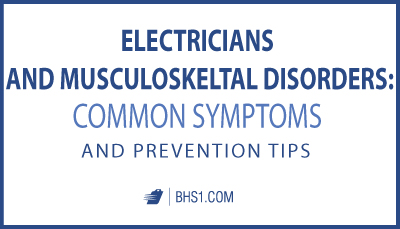We use cookies to make your experience better. To comply with the new e-Privacy directive, we need to ask for your consent to set the cookies. Learn more.
Electricians and Musculoskeletal Disorders: Common Symptoms and Prevention Tips
For electricians, musculoskeletal disorders remain a serious occupational hazard. Electrical installation teams aren't alone with this risk; workers in most construction trades face a higher risk of work-related musculoskeletal disorders than those in other industries.
Between 1992 and 2014, the rate of occupation-based musculoskeletal disorders remained higher in the construction industry than in all combined industries. This disproportionate rate of injury suggests that we need more ergonomic interventions in construction. The same is true when we zero in on electricians alone.

According to the Centers for Disease Control and Prevention, musculoskeletal disorders (MSD) include damage to soft tissues such as tendons, nerves, joints, muscles, cartilage, and the discs of the spine. In order to qualify as a work-related musculoskeletal disorder, the job must either "contribute significantly" to the occurrence of an MSD, it must make that condition worse, or it must prevent relief from the injury — or any combination of the above.
A 2016 literature review tracked MSDs across a variety of construction occupations. They found that electricians most often reported MSDs in the following parts of the body:
-
The Back - Many electricians report back pain, a condition associated with overexertion and awkward work postures, especially when workers maintain these postures over time. When electricians dig ditches for buried wire, pull long runs of cable, and squeeze into cramped spaces to accomplish work, they may increase the risk of an MSD of the back.
-
Neck and Shoulders - Working at or above shoulder level is a significant risk factor for MSDs of the neck and shoulders. Electricians perform overhead work whenever they run cable through ceiling panels and install lighting fixtures, both common tasks in the trade.
-
Hands and Wrists - Because electricians work with hand tools, sometimes repeating tasks frequently and over long periods of time, they may be at risk for developing MSDs of the hands and wrists. Carpal tunnel syndrome is a common example, although strains, sprains, and tears in the hands are also possible.
-
Knees - Electricians must frequently access narrow, hard-to-reach spaces to pull cable and install conduit. Kneeling and standing can place strain on the knees, potentially leading to MSDs.
The authors of the 2016 literature review also have some good news, though. Ergonomics solutions can help to prevent MSDs among electricians. For instance, transport devices designed specifically for electrical equipment can reduce strain and eliminate hazardous lifts. Examples include Conduit Carrier Carts, Light Fixture Carts, and Wire Coil Carts.
Mechanical material handling equipment can also prevent some of the strain associated with electrical installations. Spool Winding Trolleys eliminate manual loading for bulk payout reels, providing ergonomic benefits for suppliers and electricians preparing for an install job.
Finally, electricians see benefit from work site stretching programs. With ergonomic training and adequate electrical-material handling equipment, electricians can keep the risk of work-related musculoskeletal disorders to an absolute minimum.
References:
Choi, Sang, Lu Yuan, and James Borchardt. "Musculoskeletal Disorders in Construction: Practical Solutions from the Literature." ResearchGate. Professional Safety, Jan. 2016. Web. 20 Aug. 2018.
Wang, Xuanwen, Xiuwen Sue Dong, Sang Choi, and John Dement. "Work-related musculoskeletal disorders among construction workers in the United States from 1992 to 2014." OEM. Occupational & Environmental Medicine, 30 Dec. 2016. Web. 20 Aug. 2018.
"Work-Related Musculoskeletal Disorders & Ergonomics." CDC. U.S. Centers for Disease Control and Prevention, 1 Feb. 2018. Web. 20 Aug. 2018.
